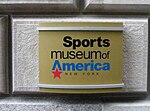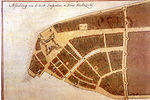Bowling Green (New York City)

Bowling Green is a small public park in the Financial District of Lower Manhattan, New York City, at the southern end of Broadway. Located next to the site of the original Dutch fort of New Amsterdam, it served as a public place before being designated as a park in 1733. It is the oldest public park in New York City and is surrounded by its original 18th-century fence. It included an actual bowling green and an equestrian statue of King George III prior to the American Revolutionary War. Bowling Green is surrounded by numerous buildings, including the Alexander Hamilton U.S. Custom House, International Mercantile Marine Company Building, Bowling Green Offices Building, Cunard Building, 26 Broadway, and 2 Broadway. The Charging Bull sculpture is located on its northern end, while Battery Park is located to the southwest. The park is listed on the U.S. National Register of Historic Places under the name Bowling Green Fence and Park. It is also a contributing property to the Wall Street Historic District, an NRHP district created in 2007.
Excerpt from the Wikipedia article Bowling Green (New York City) (License: CC BY-SA 3.0, Authors, Images).Bowling Green (New York City)
Battery Place, New York Manhattan
Geographical coordinates (GPS) Address Nearby Places Show on map
Geographical coordinates (GPS)
| Latitude | Longitude |
|---|---|
| N 40.705 ° | E -74.013611111111 ° |
Address
Bowling Green
Battery Place
10275 New York, Manhattan
New York, United States
Open on Google Maps









